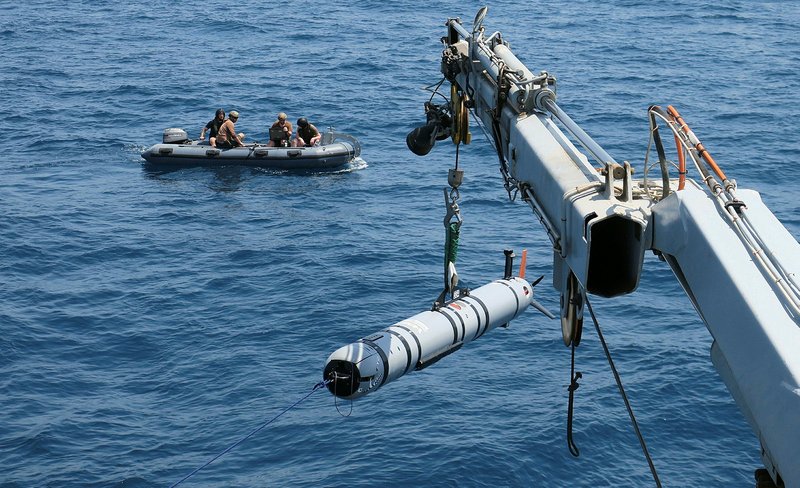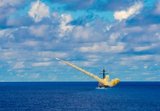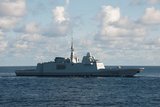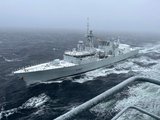Defence Insight Briefs: How market trends are shaping the future of naval defence (analysis)
The UK-led Carrier Strike Group is joined by the French Submarine Amethyst during a multi-nation exercise in March 2024. (Photo: UK MOD © Crown copyright)
In recent years, navies worldwide have faced a growing mandate to modernise fleets, increase offensive capabilities, and improve operational efficiency through uncrewed and AI-enabled systems.
The latest trends and innovations in the naval market, highlighted at the recent Euronaval 2024 exhibition, underscore this profound shift in priorities and approaches, pointing to a new era in naval warfare.
Submarines and UUVs
The underwater domain is emerging as one of the most critical growth areas in the naval defence market. With nations investing in both traditional submarines and advanced uncrewed underwater vehicles (UUVs), the market for these platforms has intensified, driven by demand for persistent surveillance and covert strike capabilities in contested regions.
The recent uptake of uncrewed platforms that leverage AI and advanced sensor suites reflects a broader movement to reinforce undersea defences. With their long-endurance capabilities and reduced staffing requirements, these systems offer navies the means to maintain situational awareness and deterrence without overstretching limited personnel resources.
For example, Naval Group’s XLUUV programme illustrates this shift, as European navies now consider uncrewed, autonomous underwater vehicles as viable options for surveillance and defensive operations.
Similarly, lithium-ion-powered submarines – seen recently in the Netherlands’ decision to acquire new diesel-electric submarines with lithium-ion batteries – mark a new direction in energy solutions, influenced by advancements from civilian industries.
This market evolution suggests that the underwater domain will continue to see robust investment and innovation, particularly as NATO nations reinforce commitments in the Atlantic and Asia-Pacific regions.
Precision strike and multi-role combatants
Across Europe and NATO countries, the emphasis on offensive capability has redefined procurement priorities in naval markets. The growing demand for strike-capable platforms, such as frigates equipped with long-range cruise missiles, reflects an awareness that modern navies must be capable of both defending territory and deterring aggression.
At Euronaval 2024, MBDA’s introduction of new strike missiles for European navies – including systems developed in cooperation with France, Italy, and the UK – illustrated the appetite for multi-nation programmes that enhance firepower while ensuring interoperability.
This trend aligns with geopolitical realities: as security dynamics evolve in regions like the Black Sea and the South China Sea, naval forces must project strength at greater distances.
In response, the market for versatile combatants such as frigates and corvettes has gained traction. These platforms, tailored for multi-mission roles, allow smaller fleets to deploy a single ship for multiple purposes, such as anti-air, anti-surface, and anti-submarine warfare.
The European Patrol Corvette (EPC) programme, funded by the European Defence Fund, is a prime example of this modular approach, enabling adaptability across diverse mission profiles while supporting shared European defence objectives.
Joint programmes and multi-nation consortia
Indeed, with defence budgets under scrutiny, collaborative programmes have become a prominent feature of the naval market.
Multi-nation partnerships allow for cost-sharing and research resource pooling, driving production and deployment efficiencies. The emergence of projects such as the EPC initiative and MBDA’s joint missile development demonstrates how multinational cooperation can yield versatile, interoperable platforms suited to Europe’s collective security needs.
This trend is crucial in a market increasingly focused on interoperability among NATO allies. Beyond immediate operational needs, joint projects allow participating countries to standardise platforms and procedures, simplifying logistics and enabling seamless integration during combined operations.

As European defence markets align under programmes funded by entities like the European Defence Fund, the naval sector can expect an even greater emphasis on these cross-border initiatives, setting a model for collaborative development across other domains.
Autonomy and AI
Labour shortages and the high cost of training naval personnel have accelerated the market shift towards autonomous and uncrewed systems. For navies facing recruitment challenges, these platforms provide a scalable solution that reduces the strain on human resources without compromising capability.
This trend has led to an uptick in investments in AI-enabled systems, which can undertake high-risk tasks traditionally reserved for crewed platforms. Companies such as BAE Systems are now delivering UUVs equipped with advanced autonomy, allowing navies to monitor and patrol critical waters autonomously for longer periods.
This synergy between the civilian and military technology sectors has also spurred developments in power systems and artificial intelligence, contributing to new autonomous surface and underwater platforms.
In the coming years, autonomy and AI integration will remain strong growth areas in naval defence, with new capabilities enabling increased scale and effectiveness in surveillance and reconnaissance missions.
The path forward: flexibility, innovation and interoperability
The naval defence market stands at a critical juncture, with traditional and emerging capabilities shaping its evolution.
While geopolitical challenges have catalysed demand for offensive systems and autonomous solutions, budgetary and workforce constraints are driving innovation in modular, multi-role platforms that maximise flexibility without inflating costs.
The market’s emphasis on modular design, interoperability, and joint development programmes points toward a future where European navies and their partners can respond more effectively to a rapidly shifting global landscape.
More from Naval Warfare
-
![Maritime defence in the Mediterranean faces challenges from vulnerable land power]()
Maritime defence in the Mediterranean faces challenges from vulnerable land power
As an indispensable energy crossroads, the Mediterranean is at serious risk from grey zone disruption. As navies increasingly employ AI data centres, what happens when cutting-edge defence technologies rely on the very infrastructure most susceptible to hybrid tactics?
-
![US Navy to conduct an experimentation campaign with emerging tech in 2026 and 2027]()
US Navy to conduct an experimentation campaign with emerging tech in 2026 and 2027
The Technology Operational Experimentation Events will inform future requirements as the US Navy looks for innovative solutions across three key operational domains.
-
![Future Canadian Continental Defence Corvette will provide “Halifax-equivalent capabilities”]()
Future Canadian Continental Defence Corvette will provide “Halifax-equivalent capabilities”
Although the CDC project is still in its early stages, the Canadian Department of National Defence already has some requirements for the future platforms.
-
![US Navy to acquire micro-uncrewed underwater vehicles for ISR and coastal data collection]()
US Navy to acquire micro-uncrewed underwater vehicles for ISR and coastal data collection
The Naval Supply Systems Command is seeking authorised resellers of JaiaBot uncrewed underwater vehicles and multivehicle pods. The platforms will support undergraduate education at the US Naval Academy.
-
![NATO tests use of “undetectable, jam-proof” laser communication in maritime scenarios]()
NATO tests use of “undetectable, jam-proof” laser communication in maritime scenarios
As part of its effort to better prepare its capabilities for operations in contested and congested scenarios, NATO evaluated a Lithuanian ship-to-ship terminal designed to not be susceptible to enemy interference.





















